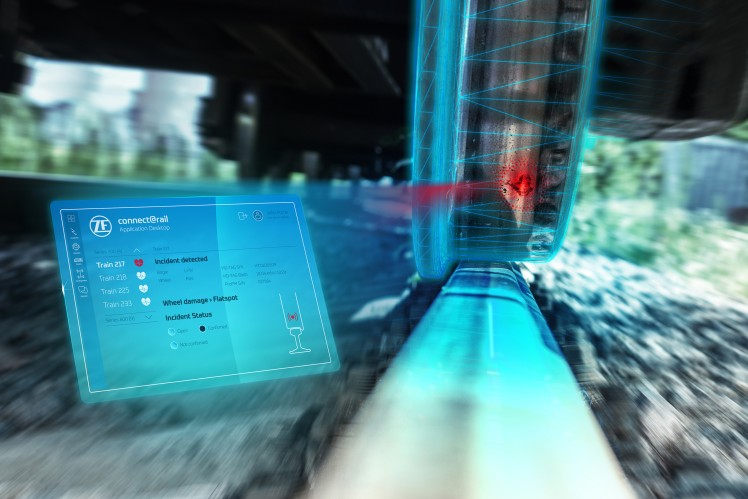And Round it Goes: ZF Expands connect@rail to Include Monitoring Feature for Wheel-tread Wear - Feature allows predictive maintenance of trains
- Monitoring function ensures more safety, efficiency and comfort
- Volume production application successful: Cooperation with DB Regio Baden-Württemberg to be extended
Friedrichshafen/Ulm. ZF is expanding its condition monitoring system for rail vehicles, connect@rail, to include a new function for wheel-tread wear monitoring. The new sensor- and cloud-based feature identifies incipient damage at an early stage, thus enabling predictive maintenance planning. This increases safety, efficiency and reliability during daily operation. The new feature is already in use at DB Regio Baden-Württemberg. Discussions are currently under way to include further rail vehicles.

Traveling by train is in trend, as this summer has shown. However, if more people are to switch to rail travel in the long run, trains must above all be reliable and safe. Essential in that regard is that transport associations are able to intelligently plan the maintenance work on vehicles. And here is where ZF steps in: Within its cooperation with DB Regio Baden-Württemberg, the technology company has supplemented its condition monitoring system for rail vehicles, connect@rail, with an additional function. The new feature detects and reports wear on the contact patches of train wheels. "With our cloud-based system, we offer rail companies a digital platform that allows them to precisely identify potential vehicle malfunctions. In that way, ZF supports rail operators by ensuring a smooth operation," says Markus Gross, Head of Product Line Rail Drive Systems at ZF.
Wheel-tread wear: minor faults, major consequences
The fact that train wheels wear out over time is a normal consequence of their use. However, things get complicated if the wear is more advanced. This can result in rough running, flat spots, microcracks or, at worst, shelling of the wheel. Even in the case of minor defects, vibrations occur, causing disturbing noises in the passenger compartments. If defects are not detected and rectified early enough, there is a risk that the vehicle's bogie will suffer damage eventually. In the worst-case scenario, not only would the train break down, but traffic on the route could also be severely congested because, for safety reasons, the vehicles may only return to the depot at a reduced speed – or, under certain circumstances, it even has to be hauled.
Condition monitoring: on the right track
"Until now, the solutions for monitoring train wheels haven't been keeping up with the possibilities," says Gross. Trains were often declared inefficient for the sake of formality and sent to the depot based on their mileage. Or things did not go beyond the mere visual inspection, which naturally could not reveal damage below the wheel surface. For connect@rail, however, ZF makes use of digitalization as well as its technology expertise in telematics and data analysis.
The condition monitoring system is based on Heavy Duty TAGs. Mounted on the wheelset bearing cover or in the bogie, these Bluetooth-based sensors record acceleration data at the wheels and transmit it to telematics gateways. The information is aggregated and sorted there before being sent to the ZF Cloud for final evaluation. Via a customer-specific dashboard, DB Regio can view this data visualized for prediction purposes and then identify potential sources of malfunction on the wheels early on. Necessary maintenance work, such as turning and reprofiling of the wheel, can therefore be planned in a predictive manner, which prevents delays in the running operation due to unplanned breakdowns.
Effective in action
DB Regio currently uses connect@rail with wheel-tread wear monitoring in southern Germany. There, the system has been installed in 15 trains from the VT650 model range that runs on different regional routes. "The cooperation with ZF has shown how much the rail industry benefits from comprehensive networking – through increased safety and reliability in passenger and freight transport," says Bernd Schlesier, Deputy Rail Operations Manager and Head of Vehicle Management for the Baden-Württemberg region.
ZF and DB Regio are currently in talks to extend the current version of connect@rail to additional vehicles. Another feature for the detection of wheel flats is already in use by the operator Graz Linien. Since the end of 2020, a total of 55 trams equipped with connect@rail have been rolling through the streets of this Austrian city.
- Feature allows predictive maintenance of trains
- Monitoring function ensures more safety, efficiency and comfort
- Volume production application successful: Cooperation with DB Regio Baden-Württemberg to be extended
Friedrichshafen/Ulm. ZF is expanding its condition monitoring system for rail vehicles, connect@rail, to include a new function for wheel-tread wear monitoring. The new sensor- and cloud-based feature identifies incipient damage at an early stage, thus enabling predictive maintenance planning. This increases safety, efficiency and reliability during daily operation. The new feature is already in use at DB Regio Baden-Württemberg. Discussions are currently under way to include further rail vehicles.

Traveling by train is in trend, as this summer has shown. However, if more people are to switch to rail travel in the long run, trains must above all be reliable and safe. Essential in that regard is that transport associations are able to intelligently plan the maintenance work on vehicles. And here is where ZF steps in: Within its cooperation with DB Regio Baden-Württemberg, the technology company has supplemented its condition monitoring system for rail vehicles, connect@rail, with an additional function. The new feature detects and reports wear on the contact patches of train wheels. "With our cloud-based system, we offer rail companies a digital platform that allows them to precisely identify potential vehicle malfunctions. In that way, ZF supports rail operators by ensuring a smooth operation," says Markus Gross, Head of Product Line Rail Drive Systems at ZF.
Wheel-tread wear: minor faults, major consequences
The fact that train wheels wear out over time is a normal consequence of their use. However, things get complicated if the wear is more advanced. This can result in rough running, flat spots, microcracks or, at worst, shelling of the wheel. Even in the case of minor defects, vibrations occur, causing disturbing noises in the passenger compartments. If defects are not detected and rectified early enough, there is a risk that the vehicle's bogie will suffer damage eventually. In the worst-case scenario, not only would the train break down, but traffic on the route could also be severely congested because, for safety reasons, the vehicles may only return to the depot at a reduced speed – or, under certain circumstances, it even has to be hauled.
Condition monitoring: on the right track
"Until now, the solutions for monitoring train wheels haven't been keeping up with the possibilities," says Gross. Trains were often declared inefficient for the sake of formality and sent to the depot based on their mileage. Or things did not go beyond the mere visual inspection, which naturally could not reveal damage below the wheel surface. For connect@rail, however, ZF makes use of digitalization as well as its technology expertise in telematics and data analysis.
The condition monitoring system is based on Heavy Duty TAGs. Mounted on the wheelset bearing cover or in the bogie, these Bluetooth-based sensors record acceleration data at the wheels and transmit it to telematics gateways. The information is aggregated and sorted there before being sent to the ZF Cloud for final evaluation. Via a customer-specific dashboard, DB Regio can view this data visualized for prediction purposes and then identify potential sources of malfunction on the wheels early on. Necessary maintenance work, such as turning and reprofiling of the wheel, can therefore be planned in a predictive manner, which prevents delays in the running operation due to unplanned breakdowns.
Effective in action
DB Regio currently uses connect@rail with wheel-tread wear monitoring in southern Germany. There, the system has been installed in 15 trains from the VT650 model range that runs on different regional routes. "The cooperation with ZF has shown how much the rail industry benefits from comprehensive networking – through increased safety and reliability in passenger and freight transport," says Bernd Schlesier, Deputy Rail Operations Manager and Head of Vehicle Management for the Baden-Württemberg region.
ZF and DB Regio are currently in talks to extend the current version of connect@rail to additional vehicles. Another feature for the detection of wheel flats is already in use by the operator Graz Linien. Since the end of 2020, a total of 55 trams equipped with connect@rail have been rolling through the streets of this Austrian city.
MEDIA
CONTACT

Svenja Mayer

